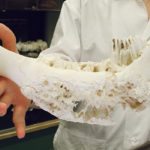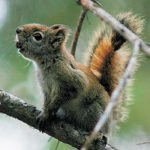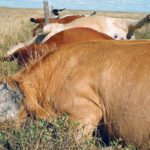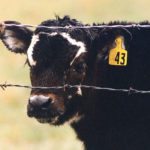Four giant pandas recently journeyed from Toronto to Calgary to join the Calgary Zoo collection. But these bamboo-eating bears will be restricted from public visits until May. During this period, the pandas will get acquainted with their new surroundings and caretakers. It also functions as a type of quarantine to allow caretakers and veterinary staff […] Read more
Stories by Jamie Rothenburger, DVM

Painful lumpy jaw disease requires intervention
As the name implies, cattle infected with the condition known as lumpy jaw develop hard lumps along the jaw, or rarely, other facial bones. The disease is a severe, deep bone infection that typically starts when there is damage to the gums. Infection establishes in the tooth socket and spreads from there to invade deep […] Read more

Case of the eyeless squirrel provides insight into natural world
It is a rare day when I diagnose an animal with missing parts at autopsy. In the fall of 2015, a concerned citizen found a young, female blind squirrel foraging on windfall apples near Windsor, Ont., and sent it to a wildlife rehabilitation centre. With no hope of long-term survival in the wild, the blind […] Read more

Examining dead stock for causes of death is valuable
The diesel engine snarled to life and I headed out of town. Reaching the feedlot, I rumbled past rows of feed bunks with various sized steers and heifers, placidly chewing their cuds or rummaging for grain in what would be their final home before entering the plant that would turn their flesh into beef. An […] Read more

Lead toxicity the most common animal poisoning: study
Researchers at the Western College of Veterinary Medicine at the University of Saskatchewan have studied animal poisonings over 16 years and found nearly half were caused by lead and most occurred in the spring and summer. Vanessa Cowan and Barry Blakely examined records in the Prairie Diagnostic Laboratory database and published their results in the […] Read more

Co-infections have major influence on infectious diseases
Animals are infected by more than one infectious agent at a time in natural settings. Thus, co-infections are the norm rather than the exception. However, since the scientific revolution that tied microscopic infections to disease — the “germ-theory” of disease — most re-searchers have focused on one pathogen infection at time. This was a reasonable […] Read more

Lungworm issues can be difficult to diagnose
Parasites that live in animals’ digestive tracts are the most frequent and arguably the most important parasites to infect animals. However, parasites can occupy a variety of organs in the body, including the skin, brain and kidney. A lesser-known class of parasites are those that reside in the lungs and windpipe. These lungworms affect a […] Read more

Horse owners warned to scout pastures for toxic Alsike clover
Unlike their counterparts in the southern United States, Canadian horse owners have relatively few toxic pasture plants to contend with. One is Alsike clover. The plant is thought to have originated in Sweden and was introduced to Canada as a forage plant in the 1800s. Since it thrives in cold climates, it is particularly common […] Read more

Keep horses healthy and safe during summer travel season
With spring underway, equine events are beginning to pop up on calendars across the country. Whether you travel with your horse for a local trail ride or head to a big competition, there are health and safety considerations to take into account before leaving home. Whenever horses gather together from different properties, a risk of […] Read more

International horse trade raises risk of infectious disease
For centuries, people have taken their domestic animals, and the diseases they carry, around the world. Spanish conquistadors brought herds of horses on ships from the Old World to North America. Those that escaped or were set free became the founding populations of the familiar North American breeds including the feral mustangs, Appaloosas, Paints and […] Read more




